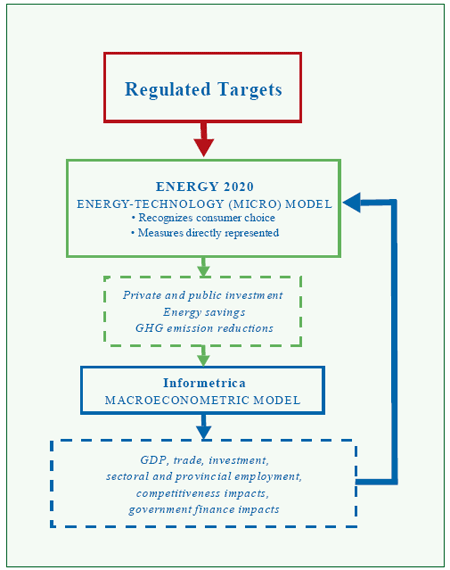
The approach used in analyzing the economic consequences of meeting Canada's emissions reductions under the Kyoto Protocol is comprised of three major components:
Business-as-Usual Scenario - The most important assumption is the "business-as-usual" (BAU) outlook, which projects emissions growth in the absence of additional policy. The BAU reflects the most recent understanding of oil and gas development and prices, additions to electricity generation capacity and improvements in energy intensity. The key assumptions in the modeling structure were aligned with NRCan's Canada's Energy Outlook: The Reference Case 2006.
Policy package and other assumptions - This includes the required greenhouse gas targets by sector, simulated carbon tax levels and international carbon credit trading parameters.
Modeling Structure - The model structure is comprised of two models: i) ENERGY 2020, a detailed energy-technology model of Canadian energy markets; and ii) The Informetrica Model (TIM), a macroeconometric model of the Canadian economy developed by the Ottawa-based consulting firm Informetrica Ltd.
As illustrated in Chart 1, the analytic process operates by first modeling the policy package in ENERGY 2020. In this phase of the analysis industrial targets and carbon charges are directly evaluated for their emissions and financial impacts (i.e. private and public investments, energy savings/change in energy mix, permit transactions and emissions reductions). The estimates of the incremental investments, energy costs and savings, and implied GHG emissions charges become inputs to the TIM model that estimates the GDP, employment, trade, government finance and other measures of economic performance. The impacts of output, employment and investment changes are fully diffused across energy markets and the economy via a feedback mechanism between the two models.
Chart 1: The Analytic Approach

E2020 is an integrated multi-region, multi-sector North American model that simulates the supply, price and demand for all fuels. E2020 can determine energy output and prices for each sector, both in regulated and deregulated markets. In short, E2020 examines the choices that consumers and businesses make in the purchase and use of energy, in response to factors such as energy prices and government policies.
The model's main outputs include changes in energy use, energy prices, GHG emissions, investment costs and potential cost savings resulting from the policy change. These results help to identify the direct effects of GHG reduction policies. The investments and savings, in turn, are inputs to the macroeconomic analysis, which assesses the impact of these investments as well as monetary flows on the whole economy.
The Informetrica Model (TIM) examines consumption, investment, production and trade decisions in the whole economy. This analysis captures not only the interaction among industries, but also the implications for changes in producer prices, relative final prices and income. It also factors in government fiscal balances, monetary flows, interest and exchange rates.
TIM represents 133 industries at a provincial and territorial level. It also has an international component to account for exports and imports, which covers approximately 100 commodities. The TIM model allocates the national results by province and territory.
TIM projects the direct impacts on the economy's final demand, output and employment, price formation, and sectoral income that result from various policy approaches. The projection estimates the effect of climate change policy and related financing assumptions on the national economy.
While very sophisticated analytical tools, no model can fully capture the complicated interactions between and within markets, and between firms and consumers associated with a given policy shock. However, macroeconomic models can provide directional guidance with respect to the broad economic consequences likely to arise from a policy change, based on the best information available, and within the constraints of the assumptions applied. Several variations of macroeconomic models exist, and have different strengths and weaknesses.
The specific modeling framework used for this analysis has several known limitations. Its strength is in modeling impacts at the national level. Sectoral and regional distributions of these impacts are regarded as somewhat less reliable. Furthermore, the model does not generate changes in nominal interest rates and exchange rates, as would occur under a monetary policy response to a major economic event. While this would mean that economic impacts may be somewhat overstated in the middle and later years of the analysis, adjustments associated with a monetary policy response would not dramatically change the overall results for the period under examination. Nevertheless, these results should be interpreted as how the economy would initially be affected by a full-blown implementation of Kyoto over the short to medium term, not how and when the economy would eventually recover from the shock.